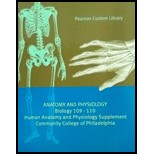
ANATOMY & PHYSIOLOGY COMM COLL PHILADELPHIA
16th Edition
ISBN: 9781323360989
Author: MARTINI & NATH
Publisher: PEARSON
expand_more
expand_more
format_list_bulleted
Question
Chapter 13, Problem 3RFT
Summary Introduction
To review:
Match the term astrocyte with the most closely related description given below:
Positive feedback
Connects initial segment to cell body
Sensory information
Monitor position/movement of joints
Myelin
One dendrite
Neuron cell bodies in PNS
Blood brain barrier (BBB)
Side branches of axons
Skeletal muscle cells
Introduction:
Astrocytes, one of the neuroglia help in the maintenance of the blood-brain barrier (BBB). The BBB is a very selective barrier membrane, which creates a barrier between the blood and the extracellular fluid present in the central nervous system (CNS).
Expert Solution & Answer
Want to see the full answer?
Check out a sample textbook solution
Students have asked these similar questions
What is the structure and function of Eukaryotic cells, including their organelles? How are Eukaryotic cells different than Prokaryotic cells, in terms of evolution which form of the cell might have came first? How do Eukaryotic cells become malignant (cancerous)?
What are the roles of DNA and proteins inside of the cell? What are the building blocks or molecular components of the DNA and proteins? How are proteins produced within the cell? What connection is there between DNA, proteins, and the cell cycle? What is the relationship between DNA, proteins, and Cancer?
Why cells go through various types of cell division and how eukaryotic cells control cell growth through the cell cycle control system?
Chapter 13 Solutions
ANATOMY & PHYSIOLOGY COMM COLL PHILADELPHIA
Ch. 13 - Match each numbered item with the most closely...Ch. 13 - Prob. 2RFTCh. 13 - Prob. 3RFTCh. 13 - Match each numbered item with the most closely...Ch. 13 - Match each numbered item with the most closely...Ch. 13 - Match each numbered item with the most closely...Ch. 13 - Prob. 7RFTCh. 13 - Prob. 8RFTCh. 13 - Prob. 9RFTCh. 13 - Prob. 10RFT
Ch. 13 - 11. Which of the following is not a function of...Ch. 13 - Neuroglia found surrounding the cell bodies of...Ch. 13 - The most important function of the cell body of a...Ch. 13 - Fill in the blanks below with the proper...Ch. 13 - 15. Axons terminate in a series of fine extensions...Ch. 13 - Prob. 15RFTCh. 13 - Prob. 1RCCh. 13 - Prob. 2RCCh. 13 - 3. Developmental problems in the growth and...Ch. 13 - Prob. 4RCCh. 13 - How does exteroceptor activity differ from...Ch. 13 - Prob. 6RCCh. 13 - Prob. 7RCCh. 13 - Prob. 8RCCh. 13 - Prob. 9RCCh. 13 - Prob. 10RCCh. 13 - Prob. 1CTCh. 13 - Prob. 2CTCh. 13 - Prob. 3CT
Knowledge Booster
Learn more about
Need a deep-dive on the concept behind this application? Look no further. Learn more about this topic, biology and related others by exploring similar questions and additional content below.Similar questions
- In one paragraph show how atoms and they're structure are related to the structure of dna and proteins. Talk about what atoms are. what they're made of, why chemical bonding is important to DNA?arrow_forwardWhat are the structure and properties of atoms and chemical bonds (especially how they relate to DNA and proteins).arrow_forwardThe Sentinel Cell: Nature’s Answer to Cancer?arrow_forward
- Molecular Biology Question You are working to characterize a novel protein in mice. Analysis shows that high levels of the primary transcript that codes for this protein are found in tissue from the brain, muscle, liver, and pancreas. However, an antibody that recognizes the C-terminal portion of the protein indicates that the protein is present in brain, muscle, and liver, but not in the pancreas. What is the most likely explanation for this result?arrow_forwardMolecular Biology Explain/discuss how “slow stop” and “quick/fast stop” mutants wereused to identify different protein involved in DNA replication in E. coli.arrow_forwardMolecular Biology Question A gene that codes for a protein was removed from a eukaryotic cell and inserted into a prokaryotic cell. Although the gene was successfully transcribed and translated, it produced a different protein than it produced in the eukaryotic cell. What is the most likely explanation?arrow_forward
- Molecular Biology LIST three characteristics of origins of replicationarrow_forwardMolecular Biology Question Please help. Thank you For E coli DNA polymerase III, give the structure and function of the b-clamp sub-complex. Describe how the structure of this sub-complex is important for it’s function.arrow_forwardMolecular Biology LIST three characteristics of DNA Polymerasesarrow_forward
arrow_back_ios
SEE MORE QUESTIONS
arrow_forward_ios
Recommended textbooks for you
 Biology: The Unity and Diversity of Life (MindTap...BiologyISBN:9781305073951Author:Cecie Starr, Ralph Taggart, Christine Evers, Lisa StarrPublisher:Cengage Learning
Biology: The Unity and Diversity of Life (MindTap...BiologyISBN:9781305073951Author:Cecie Starr, Ralph Taggart, Christine Evers, Lisa StarrPublisher:Cengage Learning Principles Of Radiographic Imaging: An Art And A ...Health & NutritionISBN:9781337711067Author:Richard R. Carlton, Arlene M. Adler, Vesna BalacPublisher:Cengage Learning
Principles Of Radiographic Imaging: An Art And A ...Health & NutritionISBN:9781337711067Author:Richard R. Carlton, Arlene M. Adler, Vesna BalacPublisher:Cengage Learning Biology 2eBiologyISBN:9781947172517Author:Matthew Douglas, Jung Choi, Mary Ann ClarkPublisher:OpenStax
Biology 2eBiologyISBN:9781947172517Author:Matthew Douglas, Jung Choi, Mary Ann ClarkPublisher:OpenStax




Biology: The Unity and Diversity of Life (MindTap...
Biology
ISBN:9781305073951
Author:Cecie Starr, Ralph Taggart, Christine Evers, Lisa Starr
Publisher:Cengage Learning

Principles Of Radiographic Imaging: An Art And A ...
Health & Nutrition
ISBN:9781337711067
Author:Richard R. Carlton, Arlene M. Adler, Vesna Balac
Publisher:Cengage Learning

Biology 2e
Biology
ISBN:9781947172517
Author:Matthew Douglas, Jung Choi, Mary Ann Clark
Publisher:OpenStax
Cell Differentiation | Genetics | Biology | FuseSchool; Author: FuseSchool - Global Education;https://www.youtube.com/watch?v=gwAz_BtVuLA;License: Standard YouTube License, CC-BY